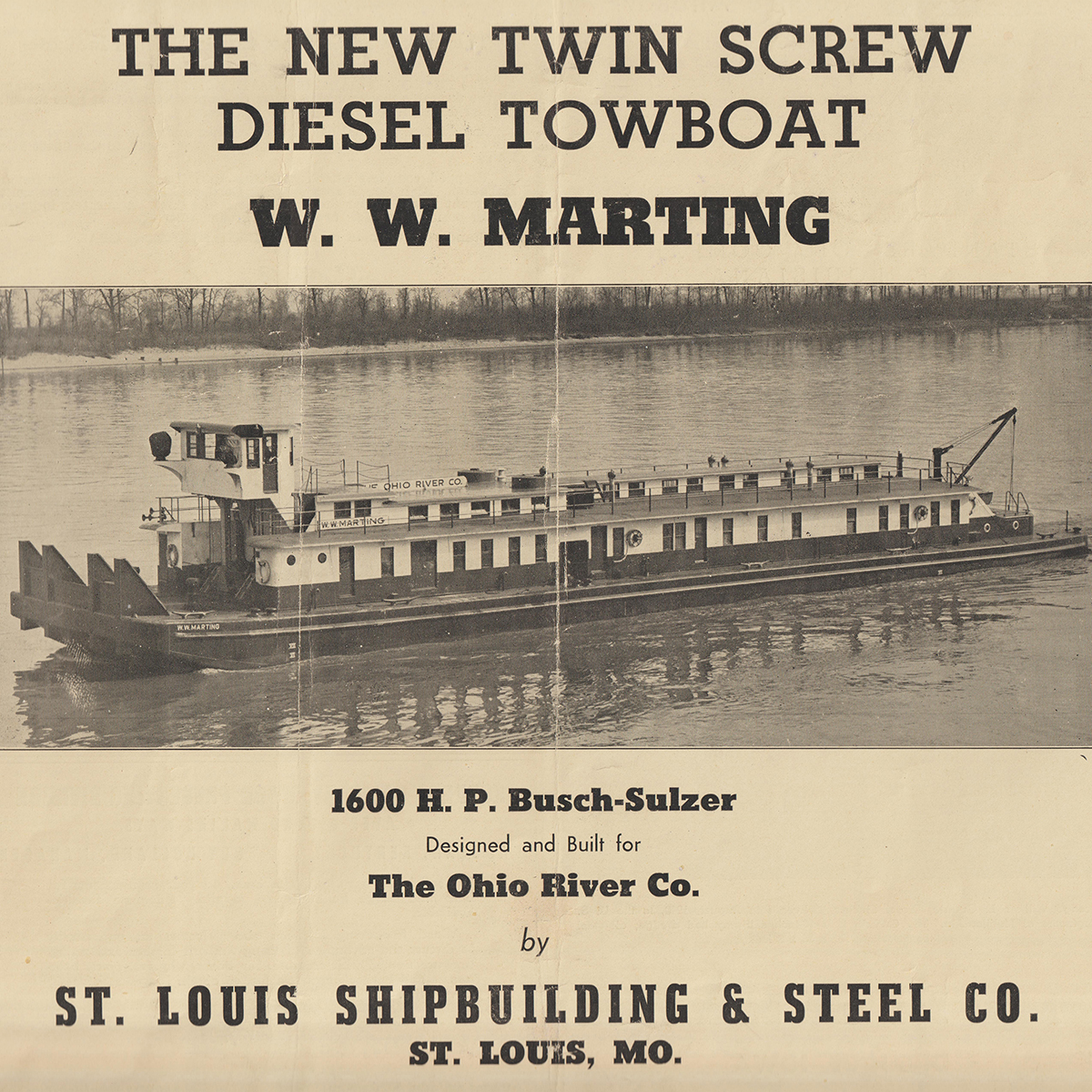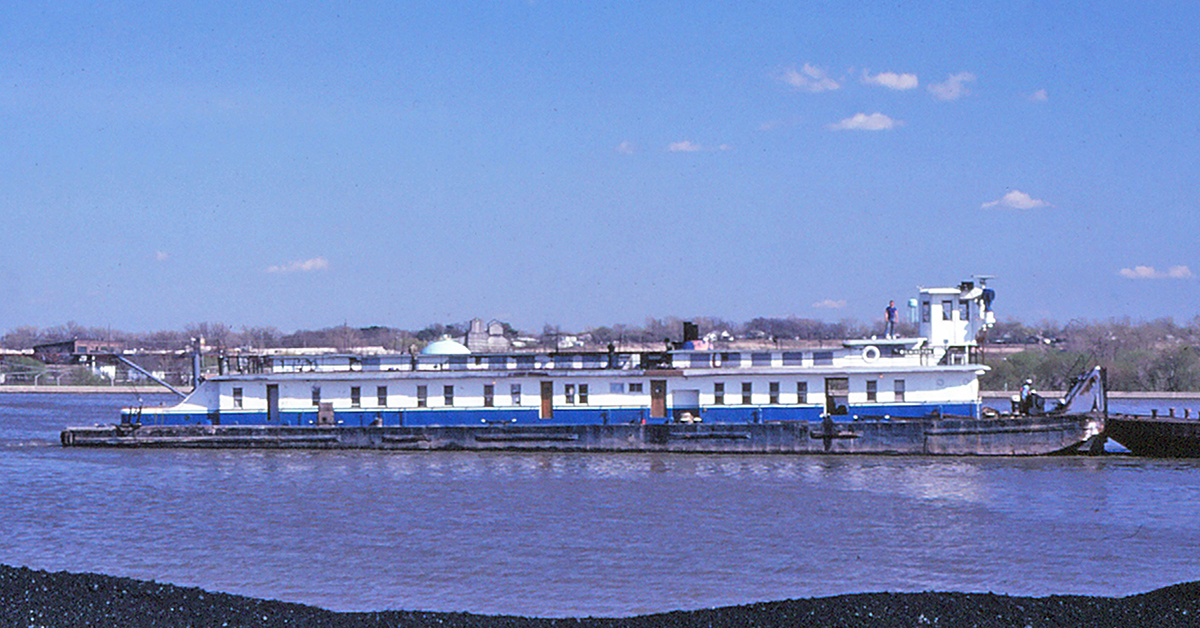The Ohio River Company grew from very humble beginnings to become one of the most iconic river towing companies of the 20th century. The late Capt. Bill Judd has detailed the history of this concern in articles appearing in the S&D Reflector over the years, noting that it has origins back to 1915, when A.C. Ingersoll, Sr. delivered coal by horse and wagon in the Cincinnati area. This operation grew into the Philadelphia and Cleveland Coal Company, which chartered towboats and barges, then purchased its own towboat in 1923. After gaining new investors, the Ohio River Company (ORCO) was incorporated in West Virginia as a wholly owned subsidiary of West Virginia Coal and Coke Company on April 17, 1925. In 1937, ORCO secured some large contracts with Commonwealth Edison to supply coal to Chicago area power plants.
In 1938, ORCO purchased the 1000 hp. diesel-powered, twin-screw towboat North Star (The Waterways Journal June 5, 2023) and converted it to Illinois River service by installing a retractable pilothouse to allow it to transit under low bridges. The North Star was the first diesel vessel owned by ORCO and the company’s first to have a retractable pilothouse. As the volume of business increased for ORCO on the Illinois, the company turned to the St. Louis Shipbuilding & Steel Company for a new towboat designed for Illinois service. This would be the beginning of a long relationship between these two companies.

The new vessel came out in 1941 and was named W.W. Marting. Marting was one of the “new investors” that A.C. Ingersoll, Sr. had gained to expand his company. After Ingersoll left in 1938 to form the Central Barge Company, Marting became the general manager of ORCO, a post he would retain until his death in 1945. His son, John Marting, became the head of the Illinois River Division, replacing A.C. Ingersoll, Jr. The Martings oversaw a huge expansion for ORCO over the next few years.
The new W.W. Marting was powered by a pair of Busch-Sulzer 6-cylinder direct-reversing diesel engines that had 16 ½ inch bore and 24 ½ inch stroke, each rated at 800 hp. at 275 rpm. The Busch-Sulzer company was founded by Adolphus Busch of the Anheuser-Busch Brewing Company of St. Louis in 1897, when he acquired rights from Rudolph Diesel to build the engines with Diesel serving as a consultant. The company was first known as Diesel Motor Company and then American Diesel Engine Company until 1911, when a joint venture was formed with the Sulzer Brothers of Switzerland, resulting in the Busch-Sulzer firm. The L-Class submarines built by the U.S. Navy in 1916-1917 were equipped with Busch-Sulzer diesels.
The W.W. Marting was constructed of all steel with a hull that was 154 feet by 34 feet with a 10-foot depth. It had a full main cabin with a raised rudder deck at the stern. A skylight ran nearly the full length of the roof of the cabin, and two short smokestacks were located over the engine room, which was positioned well forward on the boat. The elevating pilothouse was at the front of the cabin and could retract down into a notched area to allow the lowest clearance possible. The low profile of the boat made it appear longer than it really was.
Capt. Edgar “Jocko” Meek, a veteran ORCO master from the beginning of the company, was assigned to be in charge of the new Marting. Capt. Meek was a native of Catlettsburg, Ky., and was long a resident of Newport, Ky., opposite Cincinnati. He served on the first boat ORCO built, the steam sternwheel E.D. Kenna, and helped train many ORCO pilots and captains over the years.
The W.W. Marting was an ORCO mainstay on the Illinois River for the next 23 years. It was sold in 1964 to Indian Towing Company of New Orleans and renamed Timbalier. Indian also operated the tugs Chandeleur (built by Howard in 1897, WJ July 16, 2021) and Coral. In February 1971, it was sold to McQuiston Marine Lines of Pittsburgh. McQuiston renamed the boat Wilmington and repowered it with Cat D399 engines and Lufkin 4.04:1 reduction gears that gave it 2,250 hp.
In June 1978, the Wilmington was sold to Mon River Towing Inc. of Belle Vernon, Pa., and in February 1980 it was sold to G&C Towing Inc. of Point Pleasant, W. Va. It was last listed in the 1992 issue of the Inland River Record and appeared in the Off The Record section of the 1993 IRR with the notation “sold to Capt. W.A. Hollinger, Grand Rivers, Ky., for dismantling”.
I first met Capt. David Reed when he was aboard the Wilmington for Mon River Towing in the late 1970s. We became good friends, and while he was a port captain for Crounse, we traveled thousands of miles together for industry meetings and events. This continues today as even in retirement we are serving in river traffic coordination for the upcoming River Roots Festival to be held October 8-12 in Cincinnati. Capt. Reed says that the Wilmington was a good handler with a lot of room on board. Capt. Charlie Stillwell also stood watches on the boat for McQuiston. Like Reed, Capt. Stillwell speaks fondly of the boat, but both men mentioned how its length was a challenge in some narrow areas.
Featured image caption: The Wilmington at Joliet, Ill., May 1, 1975. (Photo by Jeff L. Yates)



